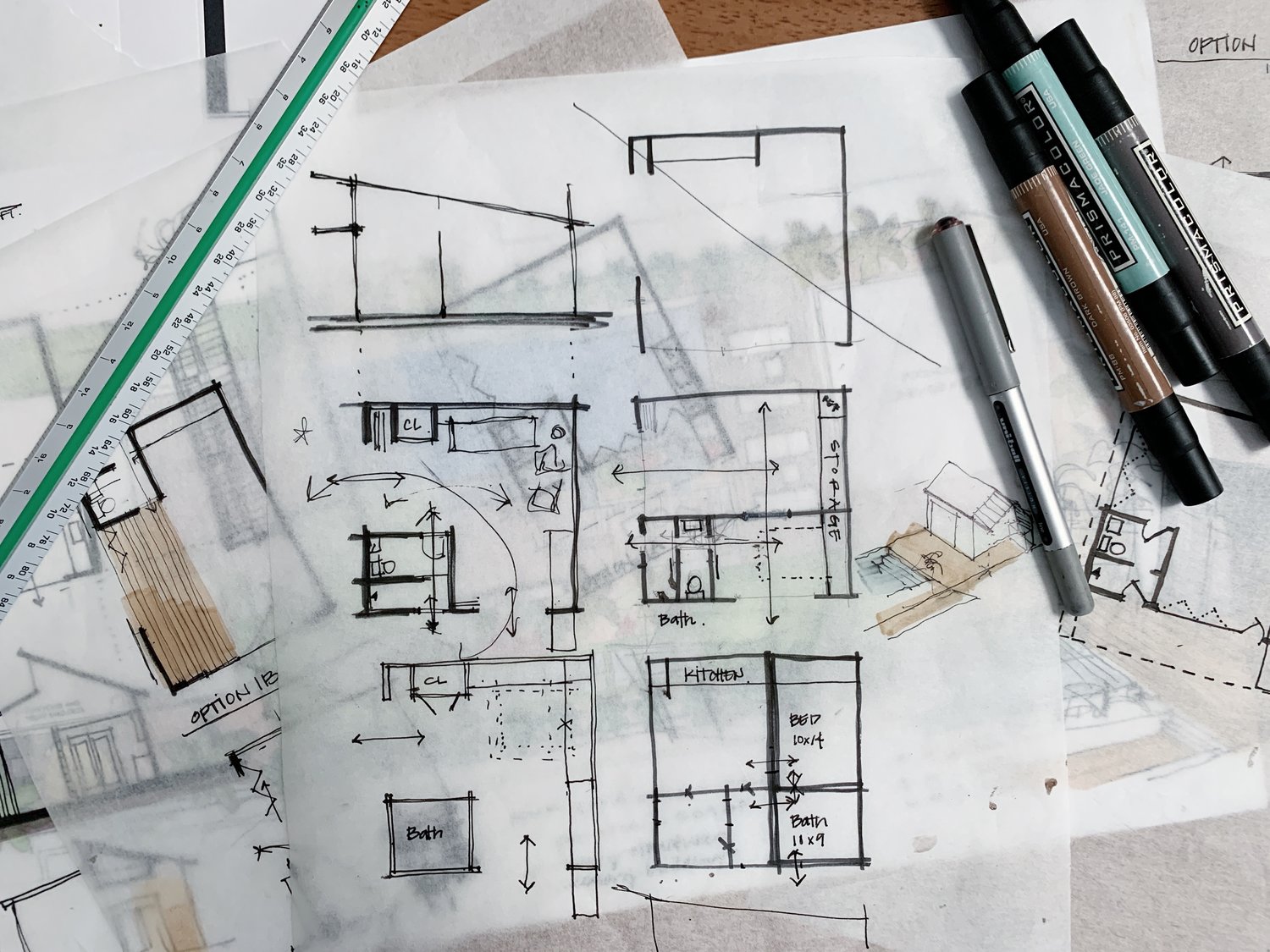Architect Portfolio Samples That Win Over Clients Instantly
Architect Portfolio Samples That Win Over Clients Instantly
Blog Article
Recognizing the Diverse Career Paths Available for Aspiring Architect
As a hopeful Architect, you have a globe of career paths waiting for you. Whether you're drawn to conventional architecture or the subtleties of sustainable design, there's a specific niche that lines up with your passions.
Typical Design: Designing Buildings and Structures
Conventional architecture concentrates on developing buildings and structures that blend functionality with visual charm. As you discover this area, you'll appreciate the complex balance in between kind and function. You'll find out to draw motivation from historical styles, incorporating components like symmetry, materials, and workmanship. Your styles can mirror social heritage, showcasing local traditions while satisfying modern-day requirements.
You'll develop abilities in composing, model-making, and website analysis, allowing you to imagine and communicate your ideas effectively. Engaging with customers, you'll require to comprehend their vision and translate it into viable styles.
In addition, developing codes and sustainability methods are vital in your job, ensuring your frameworks are ecologically pleasant and safe. As you grow in your career, you'll locate chances in residential, commercial, and even restoration tasks, each offering one-of-a-kind obstacles. Accepting conventional style leads the way for a satisfying career that admires the past while shaping the future.
Urban Planning: Forming Neighborhoods and Public Spaces
As an ambitious Architect, you can play a crucial role as a metropolitan organizer, transforming exactly how neighborhoods work and interact. By using community interaction methods, you'll ensure that citizens have a voice fit their setting. And also, incorporating lasting style concepts will assist create areas that not just satisfy today's requirements but additionally safeguard the future.
Duty of Urban Planners
While several might believe of architects as the sole visionaries behind structures, metropolitan coordinators play an important role in forming the wider landscape of neighborhoods and public areas. By working together with numerous stakeholders, you'll aid develop parks, transportation systems, and domestic locations that promote social interaction and access. Your knowledge in spatial design and area dynamics permits you to visualize future growth while protecting social heritage.
Community Engagement Techniques
Efficient area involvement strategies are important for urban organizers to guarantee that the voices of locals are listened to and valued in the preparation procedure. To cultivate meaningful discussion, you should prioritize open forums and workshops where area participants can share their ideas and worries. By proactively paying attention and including responses, you'll develop rooms that mirror the area's demands, inevitably leading to even more effective and lasting urban environments.
Sustainable Design Principles
When designing metropolitan areas, integrating sustainable style principles is critical for developing settings that thrive both ecologically and socially. You must begin by focusing on energy effectiveness, making use of materials that decrease waste and advertise recycling. Consider integrating green rooms, like yards and parks, to improve biodiversity and improve air quality. Promoting walkability and public transport can minimize dependence on cars, cultivating a much healthier area.
Creating with water conservation in mind is additionally crucial-- believe about rainfall gardens and permeable surface areas to manage stormwater. Entailing community participants during the preparation process warranties that the spaces you develop meet their needs and urge social interaction. By welcoming these principles, you'll add to dynamic, lasting metropolitan landscapes that profit everybody.

Landscape Style: Developing Lasting Outside Atmospheres
As you explore landscape style, you'll uncover crucial style principles that develop lovely and useful outside areas. Sustainable methods play an essential duty in making sure these environments grow while lessening environmental influence. Plus, you'll locate a variety of career possibilities that allow you to make an actual distinction in how people connect with nature.
Style Principles in Landscape
Recognizing layout principles in landscape design is crucial for creating lasting outside settings that balance with nature. You'll require to ponder aspects like scale, proportion, and equilibrium to assure your layouts feel cohesive and inviting. Furthermore, pay focus to seasonal adjustments, creating with products that match the environments year-round.
Lasting Practices Overview
Sustainable techniques in landscape architecture not just concentrate on looks but likewise focus on environmental health and source conservation. You can make areas that promote dirt wellness, such as making use of natural materials and practicing permaculture principles. Eventually, these techniques ensure your styles benefit both people and the environment for years to come.
Occupation Opportunities Expedition
With a solid foundation in lasting techniques, landscape style uses a variety of career courses that allow you to make a meaningful effect on the atmosphere. Urban planners commonly collaborate with landscape designers to create environment-friendly rooms in metropolitan setups, enhancing city livability. If you're passionate concerning education and learning, think about becoming a landscape architecture instructor, motivating future generations.
Sustainable Style: Concentrating On Eco-Friendly Practices
As you discover your career in architecture, welcoming green techniques can set you apart in a competitive field. Sustainable style concentrates on developing buildings that reduce ecological effect while enhancing passenger well-being. By including sustainable products, energy-efficient systems, and lasting building methods, you'll add to a greener future.
Start by getting knowledge of eco-friendly certifications like LEED or BREEAM, which can boost your qualifications. Consider exactly how all-natural light, air flow, and thermal performance can optimize style. Team up with designers and environmental experts to introduce solutions that minimize waste and preserve resources.
Do not neglect the significance of neighborhood participation-- engaging regional stakeholders can motivate designs that integrate with the environment. Learn More Here As customers progressively focus on sustainability, your proficiency in environment-friendly practices will not only draw in projects yet also satisfy your interest for accountable style. Embrace this critical aspect of the career, and watch your occupation grow.
Historical Conservation: Protecting and Bring Back Social Heritage
While you start on your building trip, take into consideration the vital role of historical conservation in keeping our cultural heritage. This field concentrates on the defense and reconstruction of substantial buildings, websites, and frameworks that tell the stories of our past. By taking part in historical preservation, you'll help safeguard the building tradition that shapes community identification.
As a historical conservation Architect, you'll assess historic importance and assess the problem of frameworks. You'll helpful resources function closely with preservationists and historians to assure authentic restoration strategies are employed. This job course allows you to blend creativity with research study, enabling you to create services that appreciate original materials and workmanship.
Your work not just contributes to sustainability by recycling existing buildings yet likewise promotes a feeling of pride within areas. Embracing this course will certainly help you come to be a guardian of history, maintaining the stories and aesthetic appeals that improve our lives.
Interior Style: Enhancing Indoor Spaces
Historic preservation and indoor style both share a commitment to improving the constructed environment, however they focus on various facets. While historic preservation stresses keeping a structure's social and historic value, interior design zeroes in on optimizing indoor areas for performance and aesthetics.
As an aspiring Architect, you'll discover that indoor style permits you to mix creativity with technical skills. You'll create areas that not only look good however additionally promote comfort and effectiveness. This area involves comprehending just how light, color, and products connect within a room, affecting state of mind and use.
You'll service numerous projects, from residential homes to industrial workplaces, ensuring that each environment fulfills the demands of its owners. By focusing on individual experience, you can transform interiors into useful and inspiring spaces, making a considerable effect on how people connect with their environments. Welcome the possibility to improve interior atmospheres and shape the way people live and work.
Industrial Design: Merging Performance With Looks
Commercial style plays a crucial role in creating products that seamlessly mix visual appeals with performance, making sure that what you utilize daily is not just aesthetically appealing yet likewise practical. As an ambitious Architect, you can engage on your own in this field, concentrating on creating everything from furnishings to consumer electronics. Your work involves comprehending user requirements, materials, and producing procedures, enabling you to develop ingenious remedies that improve day-to-day experiences.
In industrial design, you'll commonly team up with designers, manufacturers, and marketers, making sure that your layouts are not just lovely yet additionally practical. This occupation course uses a vibrant atmosphere where imagination satisfies functionality, making it a satisfying option for designers interested in shaping the items of tomorrow.
Regularly Asked Concerns
What Educational Credentials Do I Required to End Up Being an Architect?
To come to be an engineer, have a peek at this website you'll need a specialist level in architecture, generally a Bachelor's or Master's. Additionally, you'll need to complete an internship and pass the Architect Enrollment Evaluation to practice legally.
Exist Accreditation Requirements for Various Architectural Career Paths?
Yes, there're accreditation requirements for numerous architectural courses. Architect. You'll need to pass tests, complete internships, and in some cases go after specialized training, depending on your selected focus, like landscape style, city layout, or historic conservation
What Software Application Abilities Are Vital for Architects Today?

How Can I Gain Practical Experience While Researching Design?
You can acquire practical experience by interning at building firms, participating in layout competitions, offering for area jobs, or working together with classmates on real-world projects. These chances improve your abilities and develop important connections in the sector.
What Work Opportunities Exist Outside Typical Design Firms?
You can discover various task opportunities outside standard style firms, like city planning, indoor layout, landscape architecture, building and construction management, property growth, and even functions in sustainability consulting. Each deals one-of-a-kind challenges and benefits.
Whether you're attracted to traditional design or the subtleties of lasting layout, there's a particular niche that straightens with your rate of interests.When making city areas, including sustainable style concepts is essential for developing environments that prosper both ecologically and socially.As you check out landscape style, you'll discover necessary style concepts that develop attractive and practical exterior areas.Comprehending style concepts in landscape style is important for creating lasting outdoor environments that harmonize with nature.In industrial design, you'll frequently collaborate with makers, marketing experts, and designers, making certain that your layouts are not just lovely yet additionally practical.
Report this page